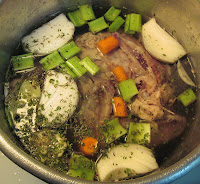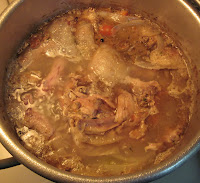 |
| Pot of homemade poultry stock |
Whenever we cook a whole chicken or turkey, I freeze the carcass and bones in freezer bags for making poultry stock at a later date. Likewise, if we find a good deal on organic whole chickens, we buy several, cut up and freeze in parts for later use, and save the wings, backs and necks for making stock. You can combine the raw parts together with the cooked bones and carcasses when making stock--in fact, I've never made stock using just raw chicken or turkey. If you don't buy whole raw chicken but instead buy cooked roasted or rotisserie chicken, you can use the carcass and bones for making stock.
It's not difficult to make homemade poultry stock, but it is somewhat time consuming so I usually reserve stock-making for weekends or for a day when I know I'll be home and able to check the stock pot periodically. For the same reason, whenever I make stock, I make A LOT all at once--I use two 12-quart stock pots--and freeze most of it in different-size containers for later use (usually 1-cup, 2-cup and 4-cup containers). Homemade stock will keep for months in your freezer and a few days in your refrigerator, and is excellent in any recipe calling for stock or broth, for making homemade soup, for cooking rice, adding flavor to casseroles or stews, and even for sauteing vegetables as a substitute for oil or butter. To turn stock into broth, simply dilute with water.
I'll often use both turkey and chicken together to make a more complex and robust stock than chicken alone. The steps are the same, and the quantities below are merely recommendations. There's no need to thaw the poultry beforehand; I use it straight from the freezer. It's hard to mess up stock, unless you over-season it (remember, the flavors intensify as the stock simmers). I do not salt my stock, for the same reason I use unsalted butter in recipes: It enables me to add the right amount of salt to the entire recipe.
 |
| Stock Seasonings |
Ingredients:
3 lbs (approx.) chicken and/or turkey carcasses, bones, backs, necks, wings
1 onion, trimmed & quartered
1 large carrot, peeled, trimmed & cut into 1" chunks
1 large rib celery, trimmed & cut into 1" chunks
2 bay leaves
1 tsp dried thyme (or 2 sprigs fresh thyme)
1 tsp dried parsley (or 4 sprigs fresh parsley)
1/4 tsp whole peppercorns
5 whole cloves
Combine the first 4 ingredients in a large stock pot. If desired, place the herbs & spices in the center of a square of cheesecloth and tie up the ends with kitchen string to make a little bag, then toss in the stock pot. Alternatively, you can add all the herbs & spices directly into the stock pot (that's what I do).
 |
| Getting ready to cook |
Reduce heat to a gentle simmer and allow to cook, uncovered, for several hours (I recommend at least 3 hours). Check each hour to skim off any fat or scum that rises to the surface, and add additional water as needed to keep the bones covered. Return to a simmer each time after adding water. Gentle cooking for a long time will bring out the best flavor and keep the stock from getting cloudy. I usually let the stock simmer for 4 to 5 hours, and stop adding water after 3 1/2 to 4 hours to allow it to get more concentrated, reducing the heat as needed to keep it from boiling.
 |
| Simmering the stock |
Once the original stock pot is empty of bones and vegetables, I carefully pour out any remaining stock into the colander/strainer. As soon as the reserved bones are cool enough to handle, I pick off any bits of meat and add some of this meat to the pureed veggie soup. The rest of the meat goes into one or more of the containers in which I'll freeze the stock (those containers eventually will be used to make chicken soup). Discard the picked bones and any skin, cartilage, herbs, spices and other solids.
At this point you can refrigerate or briefly freeze the strained stock to solidify any fat for ease of removal, OR you can go ahead and ladle out the stock into storage containers as desired. Don't forget to label the containers with the contents and date, so that you'll know what they are when you pull them from your freezer at a later date.
Zestfully yours,
Gloria

No comments:
Post a Comment